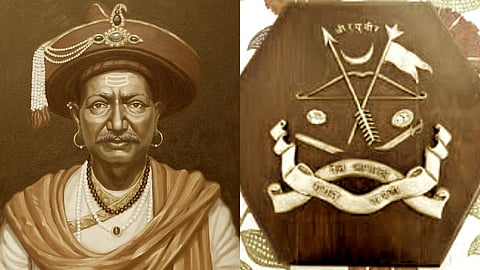- Commentary
- History Vignettes
- Notes on Culture
- Dispatches
- Podcasts
- Indian LanguagesIndian Languages
- Support

IN COMMON PARLANCE, AN AJNAPATRA means a royal edict issued on a variety of matters including administration, gifts, deeds, ratifications of say, a business charter, etc. In other cases, it was also a document meant for guidance on these matters in the sense that it was not binding.
One such brilliant if not encyclopaedic Ajnapatra was written by the formidable Amatya Ramachandra Pant who served as Shivaji’s Finance Minister in his famed Ashta Pradhan or Council of Eight. His Ajnapatra is widely regarded as the formal documentation of Shivaji’s ideals and policies of administration, and rightly so. Written in the Marathi Modi script, the work was completed on November 19, 1715. It loosely follows the model of Kautilya’s immortal Arthasastra although that work was a feat of original genius. However, what is notable when we read the Ajnapatra is again, the same point we never tire of repeating: the awesome civilizational continuity of Bharatavarsha: from Kautilya to Shivaji. Ramachandra Pant composed the Ajnapatra as both a theoretical and practical manual or guide for Shivaji’s grandson, Sambhaji II, who ruled as the Raja of Kolhapur.
The Amatya’s Ajnapatra is divided into two broad sections containing a total of nine chapters.
The first section gives valuable historical details of Pre-Shivaji times and the second, details of the Post-Shivaji period.
The second section comprising seven chapters is entirely dedicated to elucidating a vast range of topics on administration.
Evidently, this work is an invaluable primary source to understand the history of Bharatavarsha during the era told by an eyewitness.
Starting with this, we shall publish the most relevant extracts from the Ajnapatra hoping it will be of use to scholars, researchers and even regular readers.
Happy reading!
When His Majesty (Sambhaji II) ascended the throne, the desires of ail were satisfied. The whole condition of the kingdom was thoroughly considered. Therein he found that, owing to the great calamity into which it had fallen, all the servants of the state, high and low, were distressed.
Some people did not know what to do about their livelihood and had become discouraged. Some who had by their hereditary and loyal service, acquired name and fame in the kingdom, had lost their courage. They had completely abandoned their hereditary privileges and power, and had become dependent on others. Some had taken to unjust ways of life, thinking that disloyal methods were the only means of securing their subsistence.
The people’s faith that this—i.e., Haindavi Svarajya—was their only kingdom, had completely disappeared.
When this was the sad state of affairs, His Majesty pondered well over all this in his mind, and realizing that this kingdom was exclusively a divine gift, and that it should increase and prosper, he conciliated those pious and hereditary state servants who were intelligent and well-experienced, by adopting measures which would attract and hold them. Then, by gradually training their understanding, His Majesty made all of them devoted to and industrious in their work according to their abilities.
Thus, all the people got protection, thanks to the laws and regulations laid down by His Majesty. They felt secure against small troubles as well as against great dangers such as foreign invasions. They were freed from anxiety about their wealth and fame acquired hereditarily, and, without bearing any other desire or design in mind, devoted themselves wholeheartedly to the cause of their sovereign.
This kingdom was invaded by a powerful foe in the person of Aurangzeb (in a series of expeditions from 1682-1707). He used all his valour and all his resources in wealth for the destruction and conquest of this kingdom. All his attempts, however, proved fruitless by the favour of God. The result was that he got tired in his efforts, turned back and died. But having had to fight with Aurangzeb who held sovereignty over fifty-four states, who had incomparable resources in army, territory and treasury, and who was well known on this earth as the Emperor of Delhi. To defeat this emperor called for the utmost efforts and the full support of all the people. But the people came forward readily and as a consequence, they suffered heavily in the whole kingdom on account of the severe fighting.
Many kinds of articles of merchandise could not be imported from various distant countries and islands. And many soldiers also, who believed firmly that ‘the servants whose lives are lost in the cause of then master, attain that state which even the sages and yogis do not reach,’ went to heaven whilst fighting in the cause of their master in accordance with the duties of Ksatra.
But some having lost their armies got confounded in their valour and went over to the enemy. In various places persons, rising like the crescent moon owing to the weakness of government, began to quarrel against one another. During these adverse times minor chiefs such as Shyamalas got their opportunity and became firmly rooted in their power. [These were Siddis, mercenaries from Abyssinia who were seasoned naval warriors employed in the Maratha navy primarily in Janjira.]. The remaining parts of the country became desolate, and forts got exhausted of military provisions. Only the idea of the state remained.
Next, Amatya Ramachandra Pant gives us a picturesque, detailed and heartfelt portrait of Shivaji the warrior, the Chhatrapati and the protector of Hindus from the hated Yavana or Turushka. It is truly a heroic, inspiring and moving narrative written by one who had closely worked under the intrepid immortal Chhatrapati who built up the Haindavi Svarajya from the scratch.
To be continued
The Dharma Dispatch is now available on Telegram! For original and insightful narratives on Indian Culture and History, subscribe to us on Telegram.
